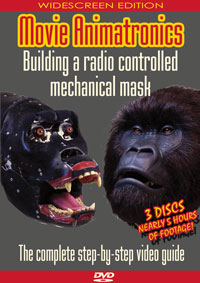As well as instructions, it's also vital to have the best reference images possible. For stranger I was very fortunate, there are some lovely CG movies within the game, and some good screenshots of them online and easily findable via google. As well as this, the publicity shots for the game are excellent, and the recent HD remake was accompanied by some very detailed blogs and some great character model shots, including several in greyscale with no texture mapping (surprisingly useful when sculpting in grey clay without fur). Finally, google furnished a few good quality images of gorillas, to fill in the blanks and provide inspiration for additional details such as fine wrinkles. All these pictures and more were printed out and put in plastic folders to protect them from the ravages of working with wet clay, and pinned up around my sculpting work space
As well as looking at reference art, it helps to create some of your own. I built a maquette of the head, a miniature sculpture made to test proportions and get a feel for the final piece. Mine was sculpted over a small porcelain ornament of a phrenology head, to make sure it was actually possible to encase a human head inside this alien head without messing up the proportions. I used this head for reference as I sculpted the full size one, and though there are some considerable differences now, it was still very useful.
The head itself would be sculpted with the eyes included, but I wanted to avoid damaging the expensive glass eyes I had purchased for this project. I made a mold of one of the eyes using silicone and made a number of plaster copies which could be incorporated into the sculpt without worrying about damage, or indeed used in other projects requiring the same size eye
A sculptor needs tools, ours are a mixture of commercially available clay working tools and home made ones created from wire, brass piping, guitar strings, pins, bits of foam and sponge, and just about anything that can be used to work soft materials
Finally, if you're going to sculpt, you need something to sculpt ON. In this case, a lifecast is absolutely essential. The one used for this project is actually cast from a friend, four of us spent a full day last year putting this thing together and it's one of the most useful objects a mask maker can own. Without a lifecast of the intended performer or at least someone with a very similarly sized head, you are forced to use things like shop dummies or wig display stands, which are almost invariable much smaller than most real people and frequently lead to heads that are too small for the wearer or which look out of proportion even if they can be forced to fit on the head
With all this in place, next time: the head sculpt.






No comments:
Post a Comment